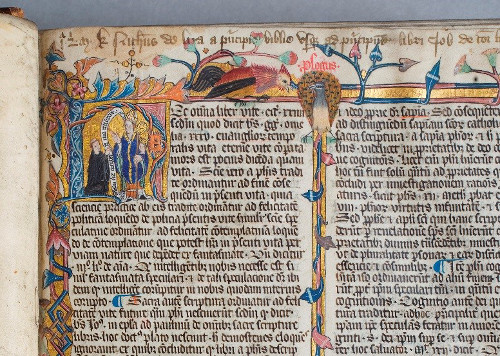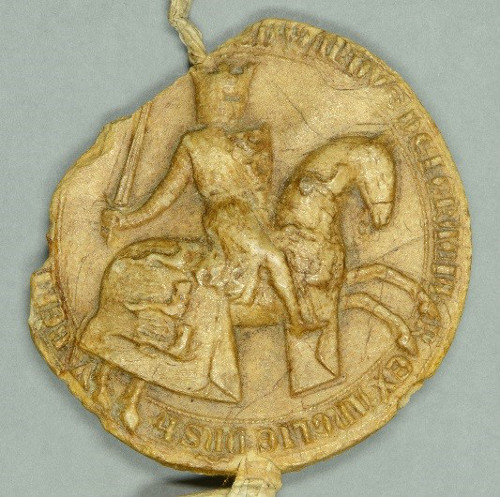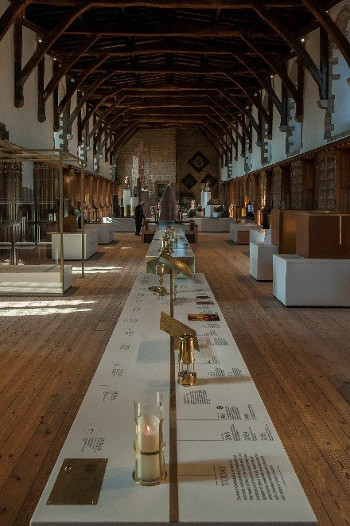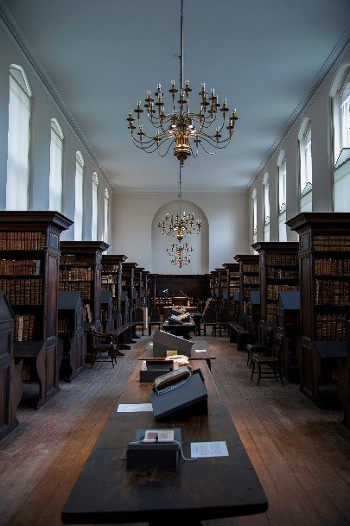
Durham Cathedral MSS A.I.3 – St Cuthbert ©Chapter of Durham Cathedral
Durham Cathedral’s Library can be traced back to the community of St Cuthbert originating in the 7th century at Lindisfarne. After fleeing Holy Island after Viking invasion, they settled in Durham in 995 bringing with them, alongside the body of Cuthbert and his sacred relics, their most precious manuscripts and scholarly works. In 1093, the Normans settled in Durham, establishing a Benedictine Community of Monks, and after the dissolution of the priory in 1539, the cathedral was re-founded under a dean and chapter who inherited much of what survived of the priory’s collection of manuscripts and printed books.
Durham Cathedral maintains the most complete in-situ medieval monastic library in Britain, built around these 308 surviving manuscripts and volumes, and also retains a collection of over 30,000 early printed books dating from the 16th to the 19th century. It also holds a manuscript music collection mostly comprising part-books used by the cathedral choir from the 17th to the 19th century, and printed secular and instrumental music. The post-1851 Chapter collection specialises in church history, local history, bibliography and architecture. We also maintain a modern theological lending library of around 15,000 titles on behalf of the Lord Crewe Trust.
The Cathedral also retains a substantial Archive, one of the most complete and extensive monastic archives to survive in Britain in its original location. Our colleagues at Durham University Library manage the Archives on our behalf. Among the many treasures held in the Archives, the Cathedral remains unique in holding three engrossments of the Magna Carta, alongside their corresponding Charters of the Forest – from 1216, 1225 and 1300.

The library is perhaps somewhat unique in that it retains responsibility not only for the paper and parchment collections owned by the Cathedral, but for all of its objects too. We care for tens of thousands of artefacts of historical, cultural, and religious significance including paintings, carved stones, textiles, metalwork, and even whale bones. The collections date as far back as the Anglo-Saxon period, and include the holy relics of St Cuthbert.
My role as Head of Collections is a busy one, overseeing the management of two Reading Rooms in order to facilitate access to the library collections (modern and historic), and since July, also having oversight of the Cathedral’s Open Treasure exhibition spaces. The claustral spaces have been opened to the public to host an interactive display showcasing the history of the Cathedral, the life of St Cuthbert and the many facets of life in a monastic community. We have also developed new exhibition galleries which will allow us to display many of the Cathedral’s treasured manuscripts and artefacts in environmentally controlled conditions. It’s an exciting opportunity to not only permanently display the relics of St Cuthbert in a beautiful environment which will help protect the objects, but also to be able to manage an ever-changing exhibition programme to allow people to see the wide range of objects held by the Cathedral. More information can be found here: https://www.durhamcathedral.co.uk/open-treasure.

To support Open Treasure, and to complement the exhibitions, new outreach programmes have been developed. The library plays a lead role through hosting visits from reading groups, displaying volumes from the collections which will hopefully inspire further learning and interest.
We will also contribute to the Education team’s Young Curator’s group. Targeting 11-15 year olds, the programme will teach children all about the art of creating an exhibition, to mirror those the Cathedral are creating.
The collections have traditionally been made available in a broader sense in a variety of ways.

Library staff undertake numerous displays and tours for all sorts of groups and to the public on a dizzying array of subjects – catering for coach parties, architecture and medieval manuscript students, specialist academics attending study days during Holy Week, potential donors, and on open days to the public.
Our visitors appreciate the opportunity to see material which is usually locked away and out of sight – it can inspire that desire to learn more and widen access to the collections in the most positive of ways, adding an extra understanding to people’s concepts about the Cathedral and its wider role.
While Open Treasure will keep us even busier, we welcome the opportunity to showcase our collections in a beautiful and environmentally stable location. If you ever find yourself in Durham, please let us know. We would be delighted to show you around.
Lisa Di Tommaso
Head of Collections
All images copyright the Chapter of Durham Cathedral and Peter Burmann and reproduced with the kind permission of the copyright holders.
Categories

